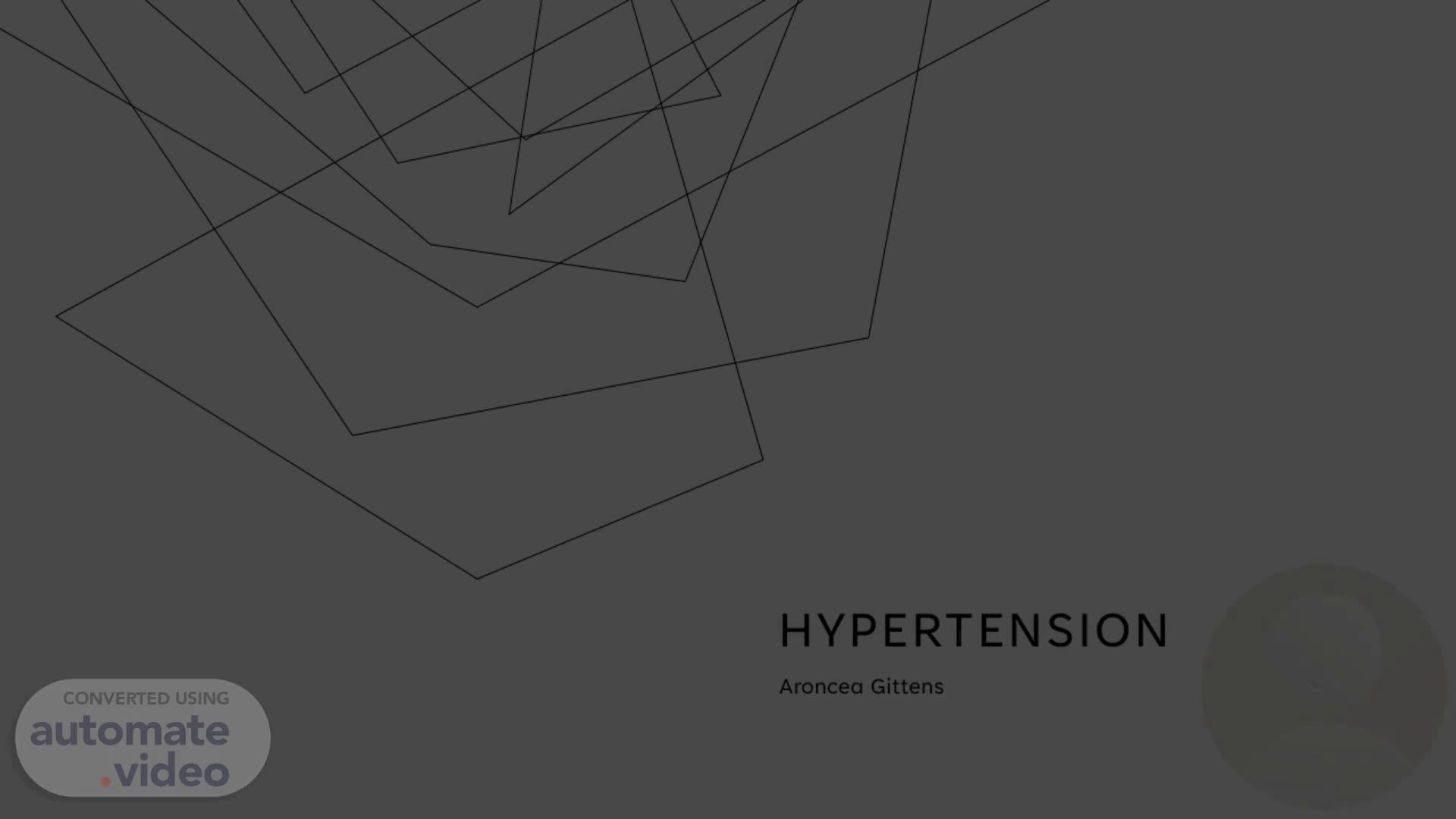Scene 1 (0s)
[Audio] Hypertension. hypertension. Aroncea Gittens.
Scene 2 (2s)
References. National Center for Chronic Disease Prevention and Health Promotion , Division for Heart Disease and Stroke Prevention https://www.ncbi.nlm.nih.gov/books/NBK554579/ https://www.ncbi.nlm.nih.gov/books/NBK539859/#:~:text=The%20prognosis%20depends%20on%20blood,hypertension%20is%20a%20progressive%20disease. https://www.ncbi.nlm.nih.gov/books/NBK554579/.
Scene 3 (4s)
[Audio] WHAT IS HYPERTENSION? Hypertension (high blood pressure) is when the pressure in your blood vessels is too high (140/90 mmHg or higher). It is common but can be serious if not treated..
Scene 4 (18s)
[Audio] Causes Things that increase the risk of having high blood pressure include: older age genetics being overweight or obese not being physically active high-salt diet drinking too much alcohol.
Scene 5 (32s)
[Audio] BLOOD PRESSURE IS WRITTEN AS TWO NUMBERS. THE FIRST (SYSTOLIC) NUMBER REPRESENTS THE PRESSURE IN BLOOD VESSELS WHEN THE HEART CONTRACTS OR BEATS. THE SECOND (DIASTOLIC) NUMBER REPRESENTS THE PRESSURE IN THE VESSELS WHEN THE HEART RESTS BETWEEN BEATS..
Scene 6 (49s)
[Audio] Signs and symptoms People with high blood pressure usually greater than 180/120 or higher severe headaches chest pain dizziness difficulty breathing nausea vomiting blurred vision or other vision changes anxiety confusion buzzing in the ears nosebleeds abnormal heart rhythm.
Scene 7 (1m 10s)
[Audio] At risk populations Rates of High Blood Pressure Control Vary by Sex and RaceA greater percentage of men (50%) have high blood pressure than women (44%). High blood pressure is more common in non-Hispanic black adults (56%) than in non-Hispanic white adults (48%), non-Hispanic Asian adults (46%), or Hispanic adults (39%)..
Scene 8 (1m 41s)
[Audio] Here is a visual of hypertension prevalence from 2018-2020 in the united states.
Scene 9 (2m 4s)
[Audio] Prognosis Among other complications, hypertension can cause serious damage to the heart. Excessive pressure can harden arteries, decreasing the flow of blood and oxygen to the heart. This elevated pressure and reduced blood flow can cause: chest pain, also called angina; heart attack, which occurs when the blood supply to the heart is blocked and heart muscle cells die from lack of oxygen. The longer the blood flow is blocked, the greater the damage to the heart; heart failure, which occurs when the heart cannot pump enough blood and oxygen to other vital body organs; and irregular heart beat which can lead to a sudden death. Hypertension can also burst or block arteries that supply blood and oxygen to the brain, causing a stroke. In addition, hypertension can cause kidney damage, leading to kidney failure..
Scene 10 (2m 56s)
[Audio] Diagnostic test YOUR DOCTOR MAY THEN PERFORM SEVERAL DIAGNOSTIC TESTS. BLOOD PRESSURE MEASUREMENT. TO MEASURE YOUR BLOOD PRESSURE, YOUR DOCTOR PLACES AN INFLATABLE CUFF AROUND YOUR ARM, WHICH MEASURES THE SYSTOLIC PRESSURE AND THE DIASTOLIC PRESSURE. ... HEART EXAM. ... EYE EXAM. ... BLOOD AND URINE TESTS. ... ECHOCARDIOGRAM..
Scene 11 (3m 19s)
[Audio] Treatments Pharmacology Thiazide-type diuretics. Calcium channel blockers. Angiotensin-converting enzyme (CCBs). Lifestyle changes eating a healthy, low-salt diet losing weight being physically active quitting tobacco.
Scene 12 (3m 38s)
[Audio] Prevention Eat more vegetables and fruits. Sit less. Be more physically active, which can include walking, running, swimming, dancing or activities that build strength, like lifting weights. Get at least 150 minutes per week of moderate-intensity aerobic activity or 75 minutes per week of vigorous aerobic activity. Do strength building exercises 2 or more days each week. Lose weight if you're overweight or obese. Take medicines as prescribed by your health care professional. Keep appointments with your health care professional..
